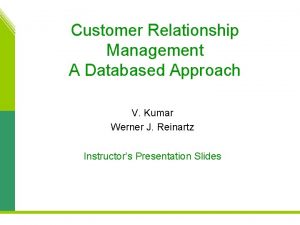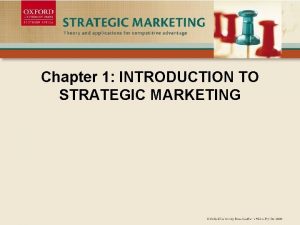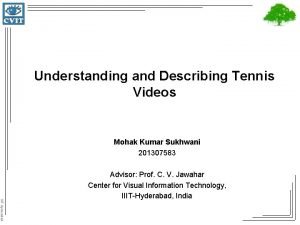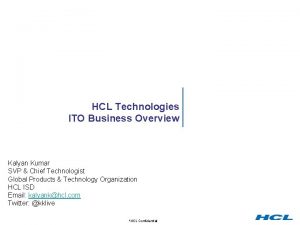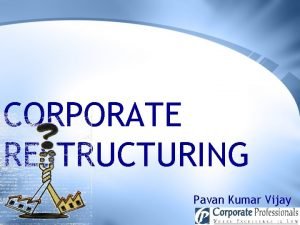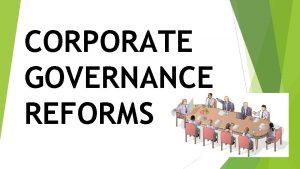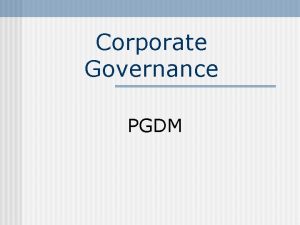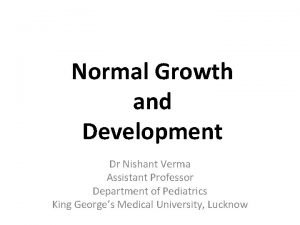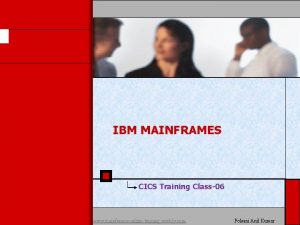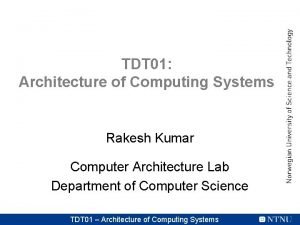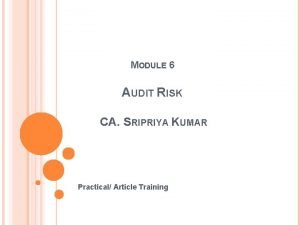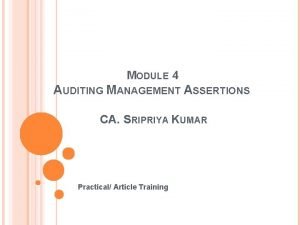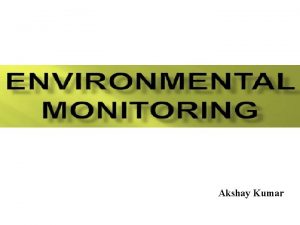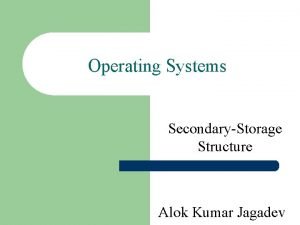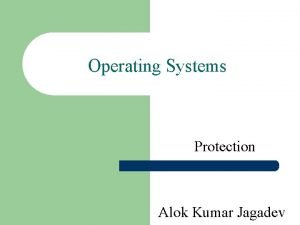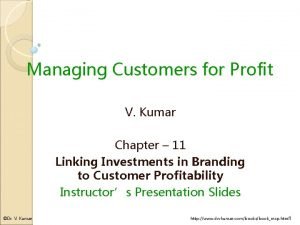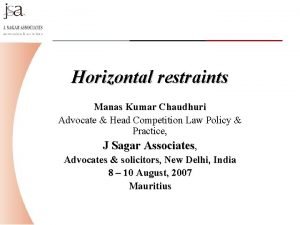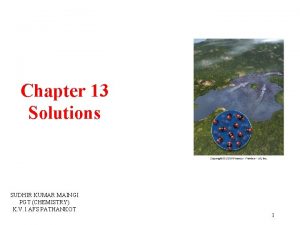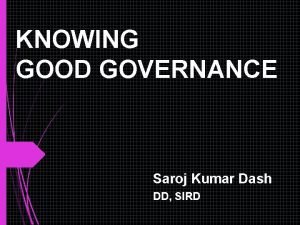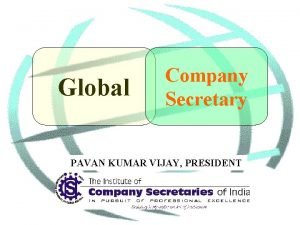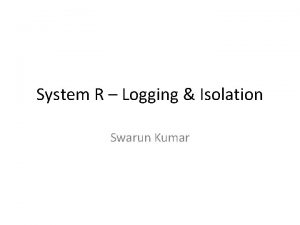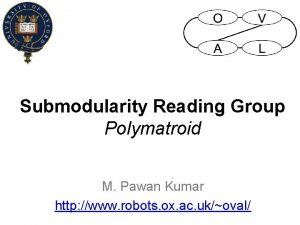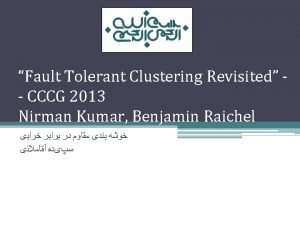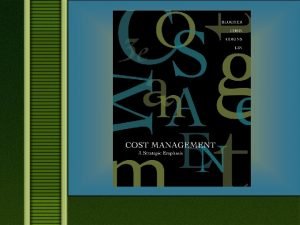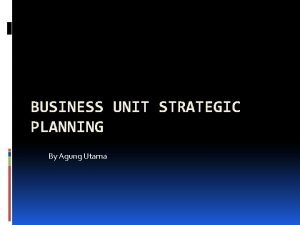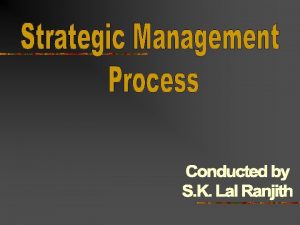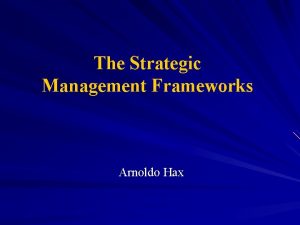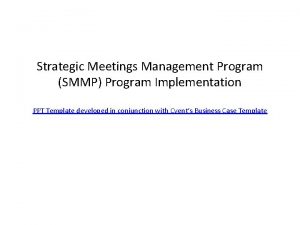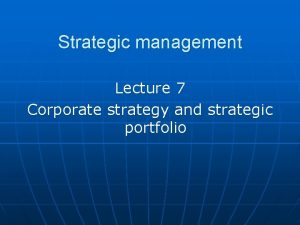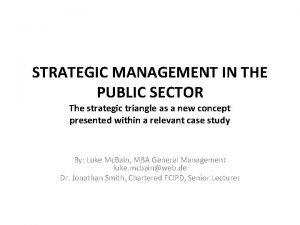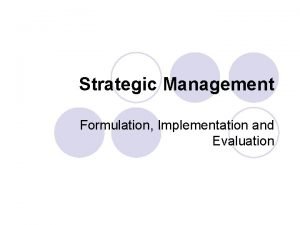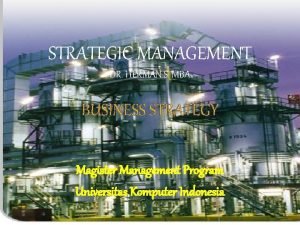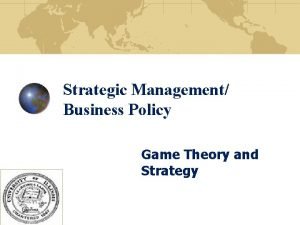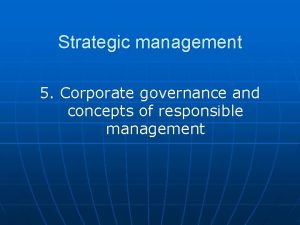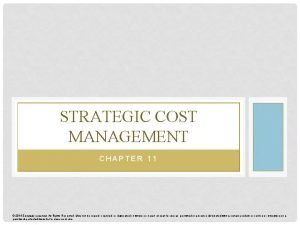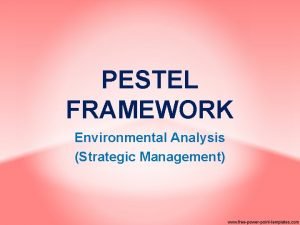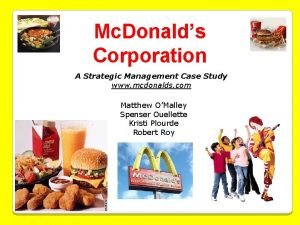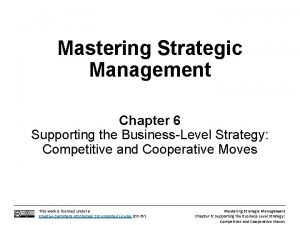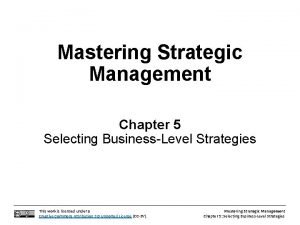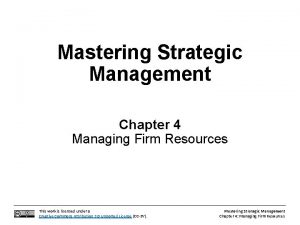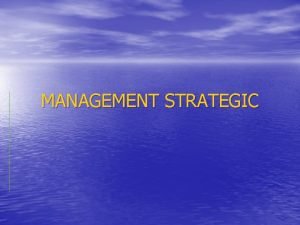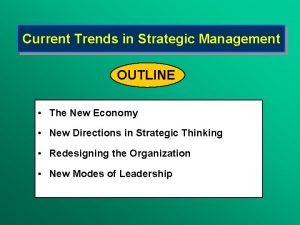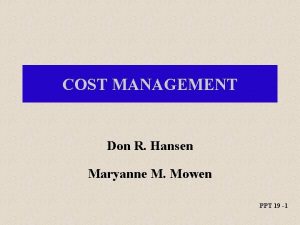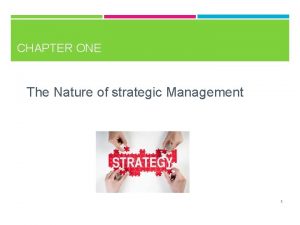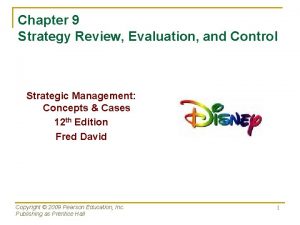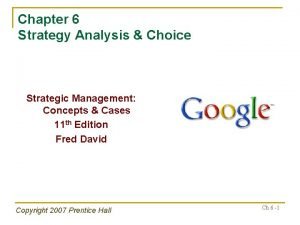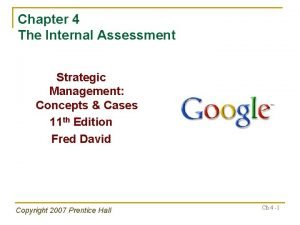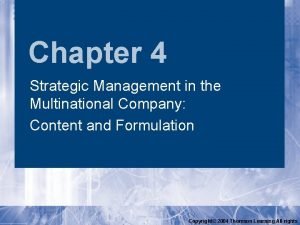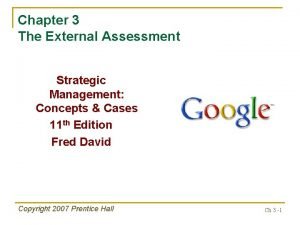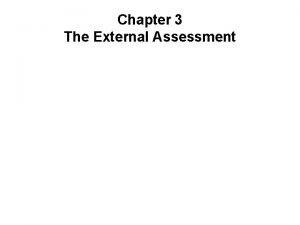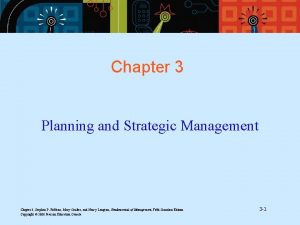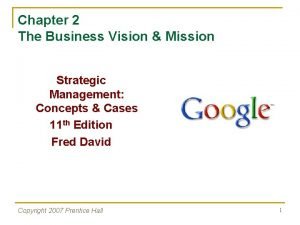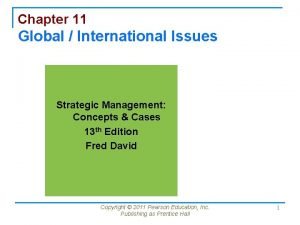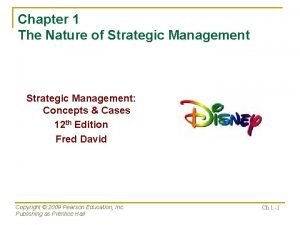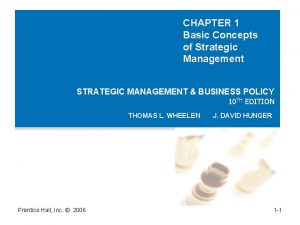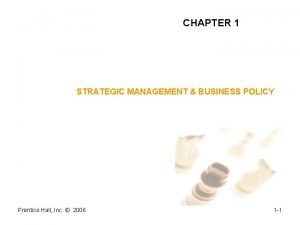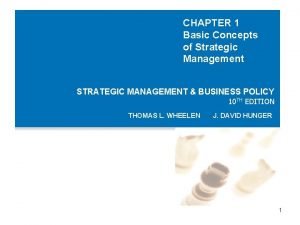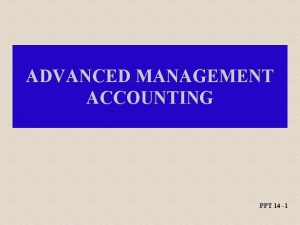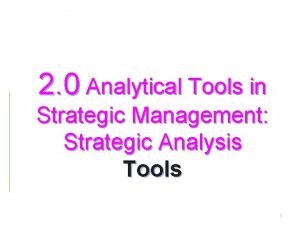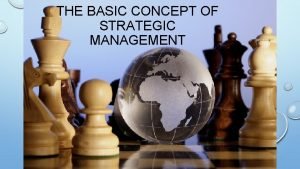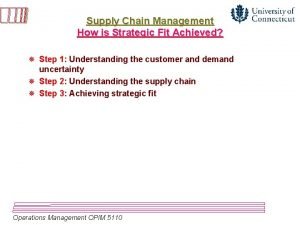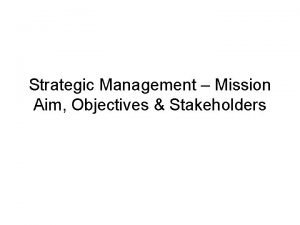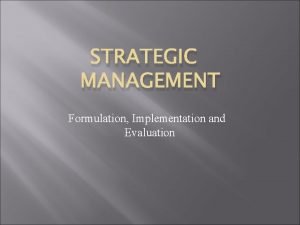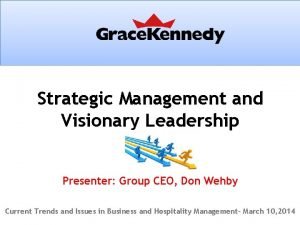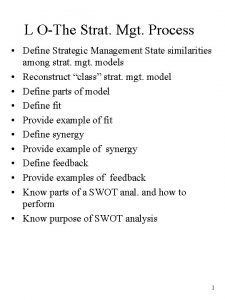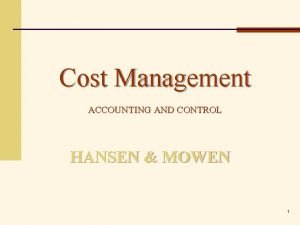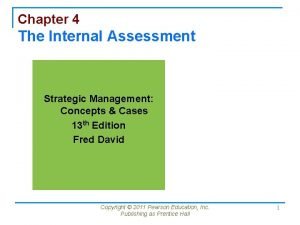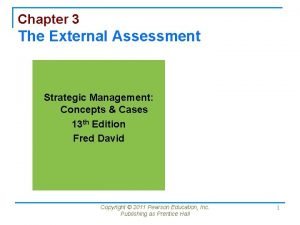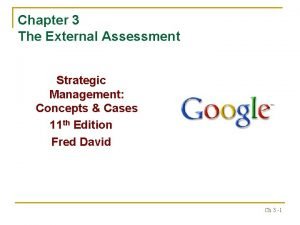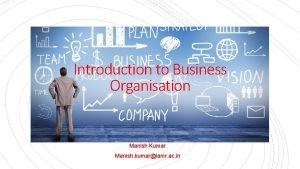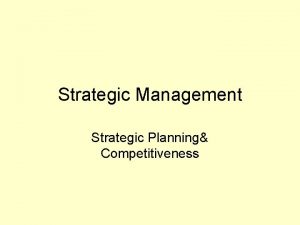Strategic Management Mr Manish Kumar Unit I Introduction
























































































































































































- Slides: 184

Strategic Management Mr. Manish Kumar

Unit I: Introduction To Business Policy and strategic Management Mr. Manish Kumar

In this unit you will study about • Nature and importance of business policy, development and classification of business policy; Mechanism or policy making

Business Policy • Policies refer to a set of management decisions oriented towards enhancing and sustaining the firm’s competitive advantage based on a system of intrinsic and extrinsic values. • Policies define the scope or spheres within which decisions can be taken by the subordinates in an organisation. • According to Koontz and O’Donnell, “ Policies delimit an area within which a decision is to be made and assure that the decision will be consistent with and contributes to objectives. • Policies are concerned with developing the general management point of view which demands that the manager sublimates his departmental, functional or specialist perspective in order to take a balanced company-wide look.

Development of Business Policy Genesis of business policy Evolution based on Managerial Practices Historical perspective of evolution of business policy Business policy in Indian scenario

Nature of Business Policy • • Objectivity Complementariness Fairness and Honesty Policy should be in writing Supplementary to other polices Consistent with public policy Relationship to other objectives • Stability and Flexibility • Being known, understood and accepted • Simple and free from ambiguity • Comprehensiveness • Ethical standards.

Elements of Business Policy Ascertaining the problem Explanation of policy Dissemination of the policy Acceptance of the policy Policy formulation Policy control Policy implementation

Objectives of Business Policy H Au elpf th ul or to iti es the ibe scr ob J De org Rela an ting i Wo satio rk ns e ag en rs k o Lin twe act el be cal f sonn i ys per h p nd a e Provid ation unic m m o c Facili ta Deter te Prem Objec ined tives

Classification of Business Policy Policies Based on expression • Oral Policy • Stated or Written policies • Implied Policy Policies Based on Levels Policies Based on of Management Situation and • Top Management contingency policies • Middle Management • Normal policies Policies • Contingency • Operating Management Polices Policies Based on Nature of origin • Originated Policy • Appealed Policy • Imposed Policy Policies Based on Function • Personnel Policies • Marketing • Finance • Production Policies Based on Scope of organisation • Basic Policies • General Policies • Specific Policies Administrative or Major Policies Departmental or Minor Policies

Mechanism of Policy Making Identification of the situation Development of Policy Dissemination of the Policy Explanation of Policy Acceptance of the Policy Feedback

Factors Influencing Business Policy Internal factors influencing Business Policy External Policy Influencing Business Policy

Internal Factors Influencing Policy • Based on practical working when new problems crop up the workers may suggest methods to get over the same and based on that a new policy may be defined. • Each and every unit if production or work bench will be preparing its own budget. The overall budget would be ready in no time. • In corporate administration, matters of debt, borrowing powers and other relevant financial matters would be decided by the Board of Directors • Shareholders may like to discuss matters pertaining to interest and divided quantum. These matters would be interpreted as a policy measure by the board of directors • The top officials after having toured round the world, might have witnessed modern and latest devise and through the policy measures introduce such measures in their concern.

External Factors influencing policy • The policy measures are first decided by the company, since its consumers who are public make representation to the company. • The government may enforce some conditions and the company business policy has to undergo change caused by the influence of the government. • International conventions may influence the business policy of the company.

l wil y enc sist Con ood ld G Bui ure Ens n He admlp in inis tra tio ilit y tab es vid Pro Pol spe icies cifi det c r erm out es ine Op uti timum sca lisatio rce n o res f our ces He implp ma ma rove nag his r to eri al p ow ers Sol pro ving b ble usi ms nes s Importance of Business Policy

Limitations of Business Policy • • Inadequate Coverage Limited Area Policies are static Consistency in policies Limited Area Polices are not end Policy provides set rules

Policies versus Procedures Basis of Difference Policies Procedures Meaning Policies are clear, simple statements of how organisation intends to conduct its services, actions or business Procedures describes how each policy be put into action in organisation Importance Policies are the business rules and guidelines of a company that ensure consistency and compliance with the company’s strategic direction Procedures define the specific instructions necessary to perform a task or part of a process Nature Policies are the integral part of the organisational strategies While procedure are used as the tactical tools in organisation. Guide Polices guide top management in decision making Procedures guide employees into action Formulation Policies are management Procedures are laid down at lower organisational levels in line with policies Reflect Policies reflect the mission statements and objectives of the company generally formulated by Top Procedures are practical applications of these polices.

Strategy • The term ‘Strategy’ is derived from the Greek word ‘Strtaegos’, which means, ‘General ship- the actual direction of military force’ as distinct from the policy governing its development. Therefore the word ‘strategy’ literally means the art of the general. • In broader sense, strategy is defined as the determination of the basic long-term objectives and goals of an enterprise and the formulation of plans and the acquisitions and utilisations of resources necessary to accomplish these goals. • According to Igor Ansoff, “ Strategy is the common thread among the organisation’s activities and product markets that defines the essential nature of business that the organisation was or planned to be in future.

Nature of Strategy • • Provides overall framework Contradictory Actions Long-Term Goals Combinations of Actions Future Oriented Competitive Guide Unified Directions • Major Course of Action • Grand Plan • Blend of Internal and External Factors • Comprehensive Objectives • Pro-Active • Dependent on System

Elements of Strategy Logic Competitive Advantage Scope Goals

Dimensions of Strategy Content Strategy Context Strategy Process

Hierarchy of Strategy Corporate level strategies Business Level strategies Functional Level Strategies

Factors that shape a company’s strategy Societal, political, regulatory and citizenship considerations Competitive conditions and overall industry attractiveness Company’s market opportunities and external threats Company's resources strengths, competencies and competitive capabilities • Personal ambitions, business philosophies and ethical beliefs of managers • Influence of shared values and company culture on strategy • •

Strategy Making Modes Rational Mode Symbolic Mode Command Mode Transactive Mode Generative Mode

Mintzberg’s 5 P’s of Strategy • The 5 P’s of Strategy model was developed by the Canadian management scientist Henry Mintzberg with an objective to develop five distinguished strategic visions for the organizations. The Five strategic visions are Plan, Pattern, Position, Perspective, and Ploy. All the five components allow the organizations to implement the strategy in a more effective manner. Plan Perspective Mintzberg’s 5 P’s of Strategy Position Pattern Ploy

Strategy as Plan • In this case, the entire strategy and its planning are done in much in advance with the long-term and a futuristic approach in mind. Aftermath, the process is followed by the actual implementation and development of the strategy. • The business goals and objectives can be attained with a good plan plus it enables the management and the key employees of the company with a clear vision and mission in hand.

Strategy as Ploy • Here, the strategy is planned and executed with a specific intention to beat and outperform the competition in the market gaining the competitive edge and advantage. • The facet of ploy is also one of the strategic options to beat the competition in the market and gain the advantage. In this scenario, the organizations can come up with something very outlandish and unexpected and surprise the market environment that also creates the waves of the ruckus within the minds of the competitors. • It can be a well placed promotional tool or a feature in the product or service that is sure to outsmart and beat the competitors as a ploy.

Strategy as Pattern • In this case, the overall strategy is emerged as a pattern considering the various internal and external situations rather than being pre-planned in nature. • The earlier patterns that have worked wonders for the organization before an integral part of developing the new strategy. The regular pattern that has been quite successful in nature is used in the decision making flow and process. • The strengths of such patterns are included in the future strategies as intentionally or unintentionally, there is a consistent positive behavior of employees and internal teams is displayed towards these patterns and are well accepted without any prejudice and issues.

Strategy as Position • Here, the organizations formulated the strategy to carve a distinctive niche or an identity in the market through exclusive products or services gaining a competitive edge in the market and in the minds of the consumers. • The aspect of position in formulating the organizational strategy needs to be carefully understood, designed, planned, and executed as it will define the overall position of the organization in the market considering all the internal and external factors. • It focuses on how the organization wants to portray itself in the market and in the minds of the consumers that will gain it a competitive advantage. What will be the core values, unique selling propositions, nature and attributes of the offerings of products and services, and the overall brand strength and value proposition.

Strategy as Perspective • In this case, the strategy is formulated as per the organizational culture and the way organization views itself. • The organization formulates the strategy by dwelling on the crucial and important details such as how does the target audience think about the organization? How do employees of the company perceive the management and the brand as a whole? What is the perspective of the investors and other stakeholders of the organization? The culmination and thought patterns of all these individual perspectives work as the valuable source of information for the company and help it to make a strategic choice.

Example of 5 P’s Strategy: Apple • Plan: The technology giant continues to plan and come up with the consumer electronics that offer operational excellence and are easy to use. They also plan and come up with the various software updates expanding their ecosystem. • Ploy: The Company is highly renowned for offering the products that are innovative, unique, and outlandish in nature that gives them a competitive edge in the market. They threaten to sue their competitors that copy their technology or features of the company’s products. • Pattern: Apple uses the previous innovations that have been quite successful in the past and follows the same pattern to challenge the competition in the market. • Position: Apple has successfully carved a niche for itself in the market and in the consumers’ minds as a niche and premium brand that offers only high-end products that are difficult to compete against in terms of both hardware and software capabilities. • Perspective: The core values of Apple are innovation and to think differently and they work as an integral part of their company culture. And their product offerings to stand as a testimony to the same.

Nu mb Qu er an com alit d pet y of Sta ition dyn bilit am y or ic ma s of rke t Soc Fac io Po tor litic s al Tec Fac hnol tor ogic s al Eco Fac nomi tor c Factors influencing strategy

Approaches to strategy making Autocratic Approach Transformational Approach Rational Approach Learning Approach Political Approach

Difference between strategy and policy Basis of Difference Strategy Policy 1. Meaning Strategy is concerned with the direction in which human and physical resources are deployed in order to maximise the chances of achieving organisational objectives in the face of environmental variables Policy is a guidelines to the thinking and action o those who make decisions 2. Nature It is a means of putting a policy into effect within certain time limits It is a general course of action with no defined time limits 3. Orientations Deals with crucial decisions whose implementations requires constant attention of top management Once policy decisions are formulated these can be delegated and implemented by others independently 4. Time Period Strategies are specific actions suggested to achieve the objectives Policies are statements or commonly accepted understandings of decision making 5. Scope Strategies are action oriented Policies are thought- oriented

Difference between strategy and tactics Basis of Difference Strategy Tactics 1. Level of conduct Developed by management; these decisions are never delegated below a certain level in management hierarchy Employed and related to lower levels of management 2. Nature So far as nature of problems is concerned, it may be said that strategic problems are unstructured in nature Tactical problems are of structured nature 3. Time Horizon Generally the focus is on long term The focus is on short-term 4. Importance Strategies are most important factors or organisation because they decide the future course of action for the organisation as a whole Tactics are of less importance because they are concerned with specific part of the organisation. This difference, though seems o be simple, becomes important from managerial point of view.

Strategic Management • Strategic management is the management of an organization’s resources to achieve its goals and objectives. Strategic management involves setting objectives, analyzing the competitive environment, analyzing the internal organization, evaluating strategies and ensuring that management rolls out the strategies across the organization. • Strategic Management is all about identification and description of the strategies that managers can carry so as to achieve better performance and a competitive advantage for their organization. An organization is said to have competitive advantage if its profitability is higher than the average profitability for all companies in its industry. • According to Glueck, “ Strategic Management is a stream of decisions and actions, which leads to the development of an effective strategy or strategies to help achieve corporate objectives.

Nature of strategic management Long Term issues Effect on operations Complex Fundamental Competitive advantage Uncertain Organisation Wide Long Term Implications

Scope of Strategic Management • The scope of strategic management is quite broad and includes within its fold almost all aspects of business operations. However the following are included in it: • Subject Matter of management: Strategic management includes strategic analysis, its choice, its formulation, its implementation and control. • Functional areas of strategic management: Issues are listed here • • • Strategic and business policies. Strategic management overview Strategic environment Types of strategy Value chain concept and analysis Integration, diversification, mergers and acquisitions Strategic change management Training strategy Implementation and control Current issues of strategic management

Framework of strategic management Strategic Intent Vision Mission Business Definition Business Model Objectives Strategy Formulation Environmental appraisal Organisational Appraisal SWOT Analysis Corporate Level Strategies Business Level Strategies Strategy Analysis & Choice Strategic Plan Strategy Implementation Project Procedural Resource Allocation Structural Behavioural Functional and operational Strategic Control Strategy Evaluation

Need for strategic management Rapidly Changing Business Environment Systematic Decision Resource Allocation Establishes Guidelines Enhanced Technologies Severe Competition among market players Research and Development

Reason for failure of strategic Management Failure to understand customer Limited Scope Leadership Over estimation Senior Management Commitment Planning Buy In Reasons for failure of strategic management Failure to manage change Other Reasons

Utility and applications of strategic management • Gives direction to organisation • Helps in forecasting • Gives reputation to organisation • Helps in grasping opportunity • Analysing the external environment • Helps in coping with uncertain environments • Facilitates development • Helps in growth of organisation • Neutralises threats • Helps in profit generation • Influences organisations performance • Ensures success

Benefits of strategic management • • Strategic directions are futuristic Strategies are defined based on study of environment Framework for operational planning Increase organisational effectiveness Strategies have multi functional and multi business effects Allocations of resource and improve co-ordination Clarity in directions of activities Personnel satisfaction

Limitations of strategic management • • • Lack of accuracy Internal resistance Costly exercise Complex and dynamic environment Danger to rigidity Difficult exercise Ineffective to overcome current crisis Inadequate appreciation of strategic management Limitations of implementations

Unit II: Top management Business objectives and Mr. Manish Kumar

In this unit you will study about • Responsibilities and tasks of top management-objectives of business characteristics, classifications, types of objectives and their overall hierarchy, setting of objectives, key areas involved.

Top Management • Top Management plays a critical role in firms as they are charged with formulating and implementing strategies effectively. • The strategic decisions made by top level managers, influence how the firm is designed and whether or not goals achieved. • Top executives need to have self-confidence but must guard against allowing it to become arrogance and a false belief in their own invincibility. • The job of Top-Level executives is complex and requires a broad knowledge of the firms operation, as well as the three key parts of the firms external environment- the general, industry and competitor environments.

Members of Top Management Chief Executive Officer (CEO) Chief Financial Officer (CFO) Chief Operations Officer (COO) Chief Technology Officer (CTO) Chief information Officer (CIO) Chief Visionary Officer (CVO) Chief Revenue Officer (CRO)

icy Det inf ermi wo rastru nes rk env cture iro nm and ent er vid Pro nt De par fines Hu amet ma n R ers fo eso r urc e ce our Res per elo Dev Fin Ma ance nag em e Pol g llin tro Con sin g ani Org ng nni Pla Responsibilities of Top Management

Task of Top Management To inspire To achieve Company Goals To provide Support and mange assets To fulfil regulatory norms To provide strategic guidance To achieve operational efficiency To manage finance

Skills of Top Management Conceptual Skills Human Skills Technical Skills

Strategic Intent • Effective strategic management begins with the organisation clearly articulating its vision for the future. The concept of strategic intent, popularised by Gary Hamel and C. K. Prahalad refers to the purpose of the organisation and the ends it wishes to pursue. • The strategic intent of the firm represents the organisations belief about its state of the future. The purpose or ends the organisation wishes to pursue vary from being really broad and long term (Vision and mission), to being narrow, with a focus on the short term or near term.

Hierarchy of strategic intent Most Integrative Fewest in Number Vision Mission Business definition Goals Objectives Most Specific Greatest in Number

Vision • A vision is more dreamt of than it is articulated. This is the reason why it is difficult to say, what vision an organisation has. • Sometimes it is not even evident to the entrepreneur who usually thinks of the vision. • According to Kotler, “ Vision is a description of something ( an organisation, corporate culture, a business, a technology, an activity) in the future. • Strategic management is a recursive, interactive, circular process, with analysis leading to some ideas on strategy, leading to questions of how to implement them, and leading to forecast of potential results- all possible leading back to a revised strategy.

Features of vision • Mental exercise • Constitutes organisations objectives and focus • Dynamic and flexible • Time-bound • Simple and concise • Pervasive • Well-defined • • Selects the target market Reflects future plans Comprehensive Anticipates future Effective Objective Orientation

Elements of strategic vision From Mission Statement to Strategic Vision Mission Statement • Mission is not to make profit • Incorporating what, who, and how into mission statements • Broad or narrow business definitions and mission • Mission statements for functional departments • • • What changes are occurring in the market arenas where we operate, and what implications do these changes have for the directions in which need to move? What new or different customer needs should we be moving to satisfy? What new or different buyer segment should we be concentrating on? What new geographic or product markets should we be pursuing? What should the company’s business makeup look like in five years? What kind of company whould we be trying to become? Communicating strategic vision

ng to egy Giv org ing m ani ea sat nin ion g to s Cre eff ating ect ive nes He fra lping min in str g at Ou fut tlinin ure g th e Bri bet dging pre ween the g sen a the p nd fut ure ani Giv wo ing m rk e He in Glping oal emp set loye tin g es Pro to vidin the g s org tren ani gth sat ion Est sta ablish exc ndard ing elle of nce Need of vision

Formulation of vision Understand the organisation Conduct vision audit Target Vision Develop future scenarios Generate alternative visions Chose the final vision Set the context

Guidelines formulating vision Learn everything about organisations Bringing the organisations major constituencies into the visioning process Encourage input from colleagues and subordinates Keep an open mind as to explore options for new vision Understand appreciate existing vision

ad Bro Too on relia nt sup erl ati ves ctiv e Not Dis tin Bla uni nd or nsp irin g Too Not loo forw kin g ard Vag inc ue o om r ple te Limitations of Vision Statement

Mission • Mission is what an organisation is and why it exists. Organisations relate their existence to satisfying a particular need of the society. They do this in terms of their mission. • Mission is a “ a statement which defines the role that an organisation plays in society”. • According to Thompson, “ Mission is the essential purpose of the organisation, concerning particularly why it is in existence, the nature of the business it in, and the customers it seeks to serve and satisfy”.

Feature of Mission Feasibility Distinctiveness Clarity Formulating a business mission statement Motivation Precision Reflection of major strategy

Formulation of Mission Key Decisions maker’s policy Visionary Long term concept Organisational Mission

Guidelines for Formulating Mission Employees should be involved Elements of mission statement should be selected carefully Length of mission statement should be proper Mission statement should be updated regularly.

Unclear Mission Statement Ineffective mission statement tend to be: Unclear Problems of strategic mission: Discourage Teamwork Static Makes effort Worthless Unrepresentative Overambitious Affects Employees Morale

Changing Mission statement Broadening Mission Being Specific Addressing Changing Times Updating Language Addressing a Merger or Split

y s tab ilit oun Acc Sta to ying roo Tru ts e Com Dir pan ect y ion s lan ine ss P Bus Mis Sta sion Bas teme ics nt Pro Ins vides comight o pan f th e y He dec lps in Ma ision kin g Benefits of Mission

Difference between Vision and Mission Basis of Difference Vision Mission 1. Definition A vision statement is what the organisation wants to become. A mission statement concerns what an organisation is all about A Vision statement describes how the future will look if the organisation achieves its mission A Mission statement answers three key questions: What do we do? For whom do we do? What is the benefit? The vision statement generally lasts for the life of the organisation A mission statement should be revisited every two to three years to make sure that the means being used to attain the vision are still relevant 2. Describe Organisation 3. Existence the

Defining Business • ‘What is our business? ’ is a pertinent question every entrepreneur asks at some point of time. • This questions needs to be answered as it Leeds to generation of ideas, which can be further built up strategy managers to arrive at a business mission statement. • A business definition is a clear statement of the business the firm is engaged in or is planning to enter. It answers the questions: what is our business, in a precise way.

Product Versus Market Oriented Definition of Business Company Product Definition Market Definition Railways We run railways We are people and goods Mover Oil Company We sell Gasoline We supply energy Copying Company We make copying equipment's We help improve office productivity As Drucker pointed out there are obvious benefits of defining a business in terms of customer’s needs. So every business needs to examine three basic questions initially before defining its nature and scope of operations: 1. Who is the customer? Where is the customer located, how to reach the customer, how does the customer buy, etc. ? 2. What does the customer buy? 3. What does the customer consider value?

Abell’s Three dimensional Model of Business definition • The Abell matrix is a three dimensional tool most often is referred to as the three dimensional business definition model. The model is used to analyze the scope of operation for a business. This may include areas such as the technologies and products a business operates in a market or the audience that it targets. • The three dimensions of the business are the customer groups (who will be served by the business), customer needs (what are the customer needs that will be met) and technology or distinctive competencies (how are these needs going to be met). A major point of importance in this matrix is to focus on understanding the customer rather than the industry and its products and services. Customer Group Technology Customer Needs

UNDERSTANDING THE MATRIX Abell used three key questions as the three dimensions on his model and these are the foundation for the formulation of the mission statement itself. • What are the customers of the organization? • How can the organization meet the needs of its customers? • What techniques are employed by the organization to meet these customer needs? • When plotted on a three dimensional model, the horizontal axis is taken as the customer groups, the vertical axis as their buying needs and the inclined axis is taken as the applied technologies. Taken together, a summarized version of the organization’s business model can be viewed in one glance.

The Three Dimensions • Customer Needs: This leg of the model identifies and lists down all the customer needs that are relevant to the company in question. Customer needs are identified based on the product offering and a link is made to customer benefits. • Technologies: Unlike the name suggests, the word technologies is taken here in a broader context to describe all those technologies that are used to create a product as well as put in on the market. Issues here include things as diverse as the marketing campaign being use or the way market research must be conducted. • Customer Groups: There would be no market without customers purchasing products on offer. This is why marketing is all about the buyers. It is vital for every organization to understand how to segment the market and which segments to target in order to successfully sell a product to them. Once the market has been segmented, the company needs to work toward acquiring as much knowledge as possible about the different target groups and offer specific products or campaigns to these segments

Vital Aspects in Defining Business Value Creation Customer Segment Product/ Service Concept

Goals • Company goals denote what company hopes to accomplish in future period of times. • They represent a future state or an outcome of the effort put in now. Broad categories of financial and non financial issues are addressed by the goals that a firm sets for it. • According to King and Cleland, “ Goals is to establish a venereal tone or organisational climate; to serve as a focus point for those who can identify with the organisational purpose and directions and to defer those who cannot, from participating in the organisation’s activities; to facilitate the translation of the broad purposes and mission into indetifiable tasks and to help in allocating organisational resources”

Cap Att able comractin of mit g me nt Pre me cise asu and rab le Rea cha listic llen an gin d g Add Cru ress cia l is sue s Spe Per cific iod Tim e s Go Addal res se Feature of Goals

Types of Goals Official Goals Operative Goals Operational Goals

Objectives of Goals • Objectives are the organisation’s operational targets, usually for periods of one year or less, and closely tied to annual budgets. They represent the intended outcomes of the organisation’s efforts to meet day-to-day needs of its customers and other direct stakeholders. • According to H. Igor Ansoff, “ Objectives are decision rules which enable management to guide and measure the firm’s performance towards its purpose”

Characteristics of Objectives Multiplicity of objectives Network of objectives Hierarchy of objectives Characteristics of Objectives Periodicity of objectives Measurability of objectives Flexibility of objectives

Importance of Objectives • Objectives serves the process of revival • Objectives act as base for business decisions • Objectives defines the organisation’s relationship with its environment • Objectives provide the standards for performance appraisal • Direction • Benchmark for success • Objectives ensure growth • Objectives provide base for decentralisation • Legitimacy • Coordination • Motivation • Objectives help an organisation to pursue its vision and mission

Classification/ Types of objectives Primary Objectives Short-Term Objectives Secondary Objectives Equilibrium Objectives Long-Term Objectives Individual Objectives Improvement Objectives Performance Objectives Social Objectives

Overall Hierarchy of Objectives Corporate Level Objectives Business Units Level Objectives Functional Level Objectives They are strategic Objectives set up by top management. They defined long-term outcomes. They consist of the following • Vision • Mission • Strategy • Long Term Profitability • Market Share growth • Product Category Shape • Product line and items • Positioning among competitive companies • Now business opportunity • Lowering cost of production • Market coverage in the chosen segment • Level of customer satisfaction • Fund generation • Programme for human resource development • New products to be launched Individual Level Objectives • Level of output per employee • Reject and waste • Sales per salesperson • Career Planning and development etc.

Major Functions of objectives • • • Defining an organisation Directions for decision-making Performance standards Basis for decentralisation Integrating organisation, group and individual.

Factors governing setting of objectives Vision and value system of top management Objectives of the past External environment and the power relations Internal resources and powerrelations

Developing Business Objectives Awareness by management Values system of top executive Forces in environment Realities of enterprise’s resources and internal power relationships

Issues in objective setting Specify Periodicity Multiplicity Reality Verifiability Quality

Key areas involved in objective setting Survival and growth Market Standing Innovation Productivity Physical and financial resources Manager performance and development Profitability Worker Performance and attitude

Difference Between Goals and Objectives Basis of Difference Goals Objectives Nature Goals are more generalised statements like maintaining market leadership, striving continuously for technological superiority etc. An objective may imply a recourse commitment requiring the organisation to use those resources in order to achieve the desired outcomes. Time Frame Goals are timeless enduring, and unending Objective are temporal, time phased and intended to be superseded by subsequent objectives Specificity Goals are stated in broad general terms, dealing with matters of image, style and self perception Objectives are much more specific stated in terms of particular result that will be accomplished by a specific date Focus Goals are usually stated in terms of some relevant environment which is external to the organisation Objectives are more internally focussed and carry important implications about how resources of the organisation are utilise or will be utilised in future

Unit III: Planning systems in business Mr. Manish Kumar

In this unit you will study about • Corporate planning, concept of long term planning, strategic planning, nature, process and importance

Planning systems • Planning may be defined as deciding in advance what is to be done in future. It is the process of thinking before doing. It involves determination of goals as well as the activities to be undertaken to achieve the goals. • The planning system or systems that are used by an organisation vary based on the sophistication or management, rates of environmental change, and level of competition experienced within a geographic region or service sector.

Objectives of Planning To achieve the predetermined goals To reduce uncertainty To economy in operation To anticipate unpredictable contingencies To bring cooperation and coordination To reduce competition

Types of Planning System Strategic Planning Long Term Planning Corporate Planning

Corporate Planning • The term corporate refers to the “business of business”, i. e. , a corporate house of a company includes all its wings related to strategic business units for different products. • Corporate planning is a continuous process in which a company first defines its philosophy, mission and vision in a strategic plan, and then uses that plan to direct, monitor and manage the business. • According to Peter Drucker, “ Corporate Planning is the continuous process of making risk-taking decisions systematically and with the greatest knowledge of their futurity- organising the efforts needed to carry-out these decisions and measuring the results of these decisions against the expectations through organisation's systematic feedback. ”

Nature of Corporate Planning Systematic Company-Wide Plan Top Level Activity Continuous Long-Term View Forward Looking Comprehensive

Objectives of Corporate Planning • • To To allocate scarce resources. cope up with environmental changes. coordinate strategies and organisational tasks. make better plans.

Process of Corporate Planning • • • Scanning the environment. Making corporate appraisals. Determining of mission and objectives. Making strategies. Developing of Action Plans. Implementing the strategy.

Importance of Corporate Planning Reduces Uncertainty Reduces Ambiguity Analysis of Environments Allocates resources Helps in Measuring success Integration Process

Limitations of Corporate Planning • • • Gathering competitive Intelligence Spotting Industry and Economic trends Time Pressure Resistance to Change Paid Change Interfacing with other departments Complex formation of reports Time to do planning Unpredictable Competition

Corporate Planning Versus Strategic Management Corporate Planning is the long range planning that focuses on the organisation as a whole Strategic Management is the process which deals with the fundamental organisational renewal and growth Corporate planning is not about strategy, it is about planning after the strategies made Strategic management is about strategy Corporate planning is not a substitute for the exercise of judgement by leadership Strategic Management is a substitute for the exercise of judgement by leadership Corporate planning is system thinking Strategic management is about strategic thinking Corporate planning is a planning process Strategic Management is a management process Corporate planning is disciplined and rigid Strategic management is disciplined and flexible Corporate planning focusses on the plan Strategic Management focuses on the people

Long Term Planning • Long term Planning is generally considered to assume that current knowledge about future conditions is sufficiently reliable to ensure the plan’s reliability over the duration of its implementation. • Long term planning has a shorter time frame than strategic planning and looks more specifically at such variables as market conditions, financial objectives and the resources necessary to accomplish the mission. • All long term planning is done within the framework of strategic plan.

Nature of Long Term planning Broad and strategic Influenced by uncertainties Combination of operational and developmental plan Accomplishment of strategic plans Covers Major areas of Business

Objectives of Long Term Planning Managing the Future Forecasting Mission and Vision Statements Direction and Motivation

Process of Long Term Planning Define Plan Identify Possible Alternatives Vision Development Framing Objective Select Opportunity Action Plan Creation

Importance of Long Term Planning Pro Active in nature Encourages Effectiveness Helps in situation Handling Prevents Problem Intensification Anticipates Social Changes

Limitations of Long Term Planning Time. Consuming Unanticipated Major Problems Technological Changes Ineffective Coordination of Activities Lack of Leadership Skill External Environment Resource Crises Might deviate from strategic vision

Strategic Planning • Strategic planning is a constituent of corporate planning. It is a systematic process of determining goals to be achieved in the foreseeable future. • It is the managerial process of developing and monitoring and maintaining viable fit between the organisations objectives, skills, and resources and its changing opportunities. The aim of strategic planning is to shape the companies businesses, products, services, and messages so that they achieve targeted profit and growth. • According to William Glueck, “ Strategic Planning is a stream of decisions and actions, which lead to the deployment of an effective strategy or strategies to help achieve corporate objectives, decisions and actions, which determine whether an enterprise excels, survives or dies.

Nature of Strategic Planning • • Accountability Flexibility Prioritisation Specificity Effective Utilisation Forming Hedge in uncertainties Balance Sustainability Futurist Planning Proactive Planning Provides Growth objectives and strategies. • Manageability • Realism • •

Reasons for the Growth of Strategic Planning • • • Increasing Rate of Technological Change Increasing complexity of external environment Focus attention on objectives Meet the challenges Continuous Process Long Term Business Plan orientation Offset Uncertainty and change Increase organisational effectives Provides better basis for making judgements

Process of Strategic Planning Establishing Goals Establishing Planning Premises 1. Internal and External 2. Tangible and Intangible 3. Controllable and Non. Controllable Deciding Planning Period Finding Alternative Course of Action Evaluation and Selection Control Implementation Feedback Develop derivative Plans

Importance of Strategic Planning Framework for developing the operating Budget Management Development Tool Mechanism to force managers to think long term Framework for Short Run Action Help in Aligning Managers with corporate strategies

Int Con er-Gr flic oup ts Mis For lead eca st Fai Int l to Pla egrat e ns Rel for uctan Ob mulat t to jec tive e s Ine Pla fficie nni nt ng Un Ma skille nag d ers Afr fail aid o ure f Ma Fai nagem ent mo l to s nit or Limitations of Strategic Planning

Difference between Strategic Planning and Corporate Planning Basis of Difference Strategic Planning Corporate Planning Degree of Uncertainty in Short Run Strategic Planning is associated with a high degree of uncertainty Corporate Planning degree of uncertainty Value Judgement Importance of Value judgement is very high in preparing strategic plans Importance of value judgement is very low in preparing corporate plans Direction Strategic Planning involves the future directions of the company Corporate planning involves determining the foundations of the business. Environment Strategic Planning helps the business respond to the external environment with goals and objectives Corporate Planning focusses on internal needs i. e. , it is related to internal environment Focus It drives the company forward and attempts to give the business an edge over competitors It deals more with internal issues. carries low

Unit IV: Aspects of Strategic Management

In this unit you will study about • Corporate strategy- Concept, components, importance and strategy formulation- concept, process and affecting factors. Strategy evaluation- Process, criteria, environment analysis, resource analysis.

Corporate Strategy • Corporate strategy often called grand strategy or master strategy provides basic direction for strategic actions. Corporate strategy is the general plan of major action by which a firm intends to achieve its long term goals. • It falls into four categories- Expansion, stability, retrenchment and combination. • Firms involved with multiple industries, businesses, product lines, or customer groups usually combine several grand strategies.

Components of corporate strategy Synergy Vector Objectives Competitive advantage

Objectives of Corporate Strategy To build competitive advantage To fill firm’s strategic gap To ensure right environmental fit

Importance of Corporate Strategy Focus A formal corporate strategy is a crucial strategic tool because it allows a corporation to focus multiple resources on a single objective Measurable Progress A corporate Strategy provides management with a benchmark to measure a company’s success or failure Long Term Success A well thoughtout corporate strategy allows a corporation to create plans and methods that will allow it to continue growing despite ups and downs of the economy or changes in the market. Other Benefits Allocation of scarce resources Motivates employees to work according to organisational goals Meet unanticipated future changes Effectiveness in implementation

Limitations of Corporate Strategy Complex process Time consuming and complicated Uncertain estimates Difficulty in achieving desired results Suitable only for long range problems

Types of Corporate Strategy Stability Strategy • Pause/ Proceed with caution • No-Change • Profit Strategy Concentration • Market Penetration • Market Development • Product Development Expansion Strategy Retrenchment Strategy • Turnaround • Captive Company Strategy • Selling out/Divestment Strategy • Bankruptcy/ Liquidation Integration • Vertical Forward Integration • Vertical Backward Integration • Horizontal Diversification • Concentric • Conglomerate Combination Strategy • Simultaneous • Sequential Internationalisation • International • Multidomestic • Global • Transnational Cooperation • Strategic Alliance • Merger • Acquisition • Joint Venture

Stability Strategies • Stability strategy or stable growth strategy though most frequently used by most of the organisation, often present a confusing nomenclature. • In fact most of such organisations look for growth and do not remain stable over the long period of time. However, when they adopt some changes in their strategy postures, they try to stabilise in a particular area, which is consistent with their strengths. • Thus basic approach in the stability strategy is ‘maintain present course: steady as it goes’.

Distinctive elements of stability strategy are: • There is no major change in product or service line, markets, or functions • The focus is on maintaining and developing competitive advantages consistent with the present resources and market requirements. • The policy thrust is aimed at not only the maintenance of the present level of performance but also ensure that the rate of improvement continuing in the past is sustained.

Types of stability strategies Profit Strategies Nochange strategy Paused/ Proceed with caution strategy

Paused/ Proceed with caution strategy • Stability as a pause strategy is pursued by those organisations whose past history is full of growth. In such case, it is desirable to maintain stability for some time to take advantages of future growth opportunities. Therefore, this strategy is also known as ‘Breathing Spell Strategy’. • The stability grand strategy is adopted by an organisation when it attempts at an incremental improvement of its functional performance by marginally changing one or more of its business in terms of their respective customer groups, customer functions, and alternative technologies-either singly or collectively.

No Change Strategy • As the term indicates, this stability is a conscious decision to do nothing new, that is, to continue with the present business definition. This could be characterised as an absence of strategy though in reality it is not so. • A No change strategy is a decision to do nothing new- a choice to continue current operations and policies foreseeable future. Rarely articulated as a definite strategy, a no change strategy’s success depends on a lack of significant change in corporations situation.

Profit strategies • No firm can indefinitely continue with a no change strategy. Sometimes things do change and the firm is faced with a situation where it has to do something. • Also called ‘Harvesting Strategy’, profit-oriented stability strategy is adopted in large companies for specific business units when generating cash flow is of prime concern for ensuring durable stability of the organisation.

Expansion Strategies • The Expansion Strategy is adopted by an organization when it attempts to achieve a high growth as compared to its past achievements. In other words, when a firm aims to grow considerably by broadening the scope of one of its business operations in the perspective of customer groups, customer functions and technology alternatives, either individually or jointly, then it follows the Expansion Strategy. • The reasons for the expansion could be survival, higher profits, increased prestige, economies of scale, larger market share, social benefits, etc.

on Coo per ati on ati alis ion rna t Int e n tio gra Int e on ati ific Div ers tio n tra cen Con Types of Expansion Strategy

Concentration • The Expansion through Concentration is the first level form of Expansion Grand strategy that involves the investment of resources in the product line, catering to the needs of the identified market with • Simply, the strategy followed when an organization coincides its resources into one or more of its businesses in the context of customer needs, functions and technology alternatives, either individually or collectively, is called as expansion through concentration. The help of proven and tested technology.

Types of Concentration Strategies • Market penetration strategy: The firm focusing intensely on the existing market with its present product. • Market Development type of concentration: Attracting new customers for the existing product. • Product Development type of Concentration: Introducing new products in the existing market. • The firms prefer expansion through concentration because they are required to do things what they are already doing. • The expansion through concentration is risky since these strategies are highly dependent on the industry, so any adverse conditions in the industry can affect the business drastically. Also, the huge investments made in a particular business may suffer losses due the invention of new technology, market fickleness, and product obsolescence.

Advantages of Concentration Strategies • Concentration involves fewer organisational changes • It is less threatening and more comfortable staying with present business • It also enables the company to specialise by gaining an in-depth knowledge of this business and thus master the knowledge. • The decision Making has a high level of Predictability • Past experience is valuable as it is replicable

Integration • The Expansion through Integration means combining one or more present operation of the business with no change in the customer groups. This combination can be done through a value chain. • The value chain comprises of interlinked activities performed by an organization right from the procurement of raw materials to the marketing of finished goods. Thus, a firm may move up or down the value chain to focus more comprehensively on the needs of the existing customers. Vertical Integration Horizontal Integration

Vertical Integration • The vertical integration is of two types: forward and backward. When an organization moves close to the ultimate customers, i. e. facilitate the sale of the finished goods is said to have made a forward integration. Example, the manufacturing firm open up its retail outlet. • Whereas, if the organization retreats to the source of raw materials, is said to have made a backward integration. Example, the shoe company manufactures its own raw material such as leather through its subsidiary firm.

Advantages of Vertical Integration • • • Increased competitiveness Greater process control Increased market share Increased supply chain coordination Decreased cost

Disadvantage of Vertical Integration • • • Capacity Balancing issue Potentially higher cost due to low efficiencies Decreased flexibility Decreased capability to increase product variety Developing new core competencies Increased Beauacratic cost

Horizontal Integration • A firm is said to have made a horizontal integration when it takes over the same kind of product with similar marketing and production levels. Example, the pharmaceutical company takes over its rival pharmaceutical company.

Advantages of Horizontal Integration • Lower cost structure • Increased product differentiation • Replicating the business model • Reduced industry rivalry • Increased bargaining power

Disadvantage of Horizontal Integration • Stunting economic growth of the new enterprise • Reduced flexibility: This happens because the company is now a larger organization. The addition of more personnel and processes means the need for more transparency and therefore, more accountability and red tape. • Destroying value rather than creating it: This happens because the synergies never materialize despite the costs of the horizontal integration.

Diversification • Diversification strategies are used to expand firm’s operations by adding markets, products, services, or stages of production to the existing business. The purpose of diversification is to allow the company to enter lines of business that are different from current operations. • Diversification strategies are used to extend the company’s product lines and operate in several different markets. The general strategies include concentric, horizontal and conglomerate diversification. • Warren Buffet on Diversification: “Diversification is protection against ignorance, it makes little sense for those who know what they’re doing. ”

Reasons for diversification Better Use of Resources Organisational Capability

Advantages of Diversification Caveats Limiting Risk Maximising returns

Disadvantages of Diversification Cost Overextension Lack of Expertise Reduced Innovation

Types of Diversification Strategies Concentric Diversification Conglomerate Diversification

Concentric Diversification • In this alternative, a company expands into a related industry, one having synergy with the company’s existing lines of business, creating a situation in which the existing and new lines of business share and gain special advantages from commonalities such as technology, customers, distribution, location. , product or manufacturing similarities, and government access. • Concentric diversification is one type of strategic thrust. Concentric diversification focusses on creating a portfolio of related businesses. The portfolio is usually developed by acquisition rather than by internal new business creation.

Features of Concentric Diversification Geographical expansion Innovative Economies of Scale

Advantages of concentric diversification • • • To counteract cyclical trend Excess cash flow Managerial expertise Combining the value chain Leveraging strong brand names Creating stronger capabilities

Disadvantages of Concentric Diversification Effects new business Complex and difficult Other disadvantages Shared risk, in some cases where diversification is extensive. Different industries have different and unpredictable business cycle • Shared loses when there are no strong commonalities to leverage competencies • High bureaucratic cost of diversification. • •

Conglomerate Diversification • An important and essential form of diversification that helps in building the internal structure of any firm or business is termed as conglomerate diversification. Conglomerate diversification helps in evaluating and preparing the business unit portfolio based on the financial position of the firm. This type of diversification is entirely different from concentric diversification. In this form, the new developed products are not directly related with the existing technologies, market as well as products. This is somehow interrelated with the financial position as well as stability of any firm or business. • Conglomerate is a term that is used for tow or more than two corporations that are involved in different set of businesses in one single corporate structure. They are generally large and huge companies.

Features of Conglomerate Diversification • Acquisitions over internal development • Attempting to beat the market

Advantages of Conglomerate Diversification 1. It helps in increasing the growth earning rates 2. Helps in creating internal capital markets 3. Helps in reducing the investment risk

Disadvantages of Conglomerate Diversification 1. The overburden management create extra costs 2. Various demographics based differences can increase the risks 3. Focus can be misbalanced

Internationalisation • The international business-level strategies are based partially on the type of international corporate-level strategy the firm has chosen. • Some corporate strategies give individual country units the authority to develop their own business level strategies; other corporate strategies dictate the business-level strategies in order to standardise the firm’s products and sharing of resources across countries. • International corporate-level strategy focusses on the scope of a firm’s operations through both product and geographic diversification. International corporate-level strategy is required when the firm operates in multiple industries and multiple countries or regions.

Internationalisation Strategies International Company strategy Multinational Company strategy Global Company strategy Transnational Company strategy

Internationalisation Strategy Pressure for Global Integration Global High Low Views the world as a single market. Tightly controls global operations from headquarters to preserve focus on standardisation International Uses existing core competitors to exploit opportunities in foreign market Low Transnational Flexible value chain enables local responsiveness, complex coordination mechanisms enable global integration Multidomestic Foreign subsidiaries operate autonomous units to customize products and processes to local market’s needs. High Pressure for national responsiveness

International Company strategy • In this strategy company extends marketing, manufacturing, and other activity outside the home country. When a company decides to pursuer opportunities outside the home country, it has evolved into this category. • In spite of its pursuit of foreign business opportunities, the international company remains ethnocentric, or home country oriented, in its basic orientation. • The marketing strategy of the international company is extension; that is products, advertising, promotion, pricing and business practices developed for the home-country market are “extended” into markets around the world.

Multinational Company Strategy • In time, the international company discovers that differences in markets around the world demand an adaptation of its marketing mix in order to succeed. • When a company decides to respond to market differences, it evolves into a multinational that pursues a multi domestic strategy. • The focus of the multinational company is multinational or in strategic terms, multi domestic i. e. , this company formulates a unique strategy for each country in which it conducts business.

Global Company Strategy • The global company makes a major strategic departure from the multinational. The global company will have either a global marketing strategy or a global sourcing strategy, but not both. • A global strategy requires worldwide consistency and standardisation in order to be effective. Firms that choose the global strategy face strong pressures for cost reduction but weak pressure for local responsiveness.

Transnational Company Strategy • This strategy aims to simultaneously exploit location economics, leverage core competencies, and pay attention to local responsiveness. It is arguably the most direct response to the globalisation of business. • The transnational corporation is much more than a company with sales, investments and operations in many countries. • The transnational company is geocentric in its orientation. It recognises similarities and differences and adopts a worldview. This is the company that thinks globally and acts locally. It adopts a global strategy allowing it to minimise adaptation in countries to that which will actually add value to the country customer.

Cooperation • Firms use three means to grow and improve their performanceinternal development, mergers and acquisitions, and cooperation. In each of these cases, the firm seeks to use its resources in ways that will create the greatest amount of value for stakeholders. • The term ‘cooperation’ expresses the idea of simultaneous competition and cooperation among rival firms for mutual benefits. Cooperative strategies could be of the following types: • Strategic Alliance • Merger • Acquisitions • Joint Ventures

Strategic Alliance • A strategic Alliance is a partnership, a collaborative partnership/ agreement and / o a relationship between two or more companies or organisations formed to pursue a set of agreed upon goals while remaining independent companies or organisations. • Strategic Alliance is a formal relationship between two or more parties to pursue a set of agreed upon goals or to meet a critical business need while remaining independent organisations.

Types of Strategic Alliance • On the Basis of Directions of Alliances: Like M 7 A’s collaborative ventures can be categorised as vertical backward (or upstream), vertical forward (or downstream), horizontal or diversified. • Diversification Alliances: Alliance between businesses in unrelated areas are often used by one or more of the businesses to take them into a new comparative arena by one or more of the businesses to take them into a new competitive arena. • Vertical Networks and alliances: These can be upstream in the supply chain towards suppliers or downstream towards distributors and customers.

On the basis of extent and timescale of collaboration • Extent of cooperation focussed and complex alliances • Timescales of the collaboration • Consortiums

Advantages of Strategic Alliances • • Spread and reduce cost Specialise in competencies Avoid or counter competition Secure vertical and horizontal links Gain location-specific assets Overcome governmental constraints Diversify geographically Minimise exposure in risky environments.

Disadvantages of Strategic Alliance • • Adverse selection Moral Hazard Hold Up Access to information Distribution to earnings Potential loss of autonomy Changing Circumstances

MERGER • Merger is an external strategy for growth of the organisation. A merger is a combination (also known as amalgamation, consolidation, or integration) of two or more organisation in which one acquires the assets and liabilities of the other in exchange for shares or cash, or both the organisations are dissolved, and the assets and liabilities are combined and new stock is issued. For the organisation, which is acquired, it is a merger. If both organisation dissolve their identity to create a new organisation, it is consolidation. • A merger is a combination of equals. Therefore it is usual for the Board of a merged company not to be dominated by the management of either of its predecessor.

Retrenchment strategies Selling out/ Divestment strategy Turnaround strategy Captive company strategy Bankruptcy/ Liquidation

Reasons to pursue retrenchment strategies • • • Poor performance Threat to survival Redeployment of resources Insufficiency of resources To secure better management and improved efficiency

Turnaround strategy • Turnaround strategy derive their name from the action involved, that is, reversing a negative trend. The overall goal of turnaround strategy is to return an underperforming or distressed company to normal in terms of acceptable levels of profitability, solvency, liquidity, and cashflow. • To achieve its objectives, turnaround strategy must reverse causes of distress, resolve the financial crisis, achieve a rapid improvement in financial performance, regain stakeholder support, and overcome internal constraints and unfavourable industry characteristics.

Captive company strategy • A captive company strategy involves giving up independence in exchange for security. A company with a weak competitive position may not be able to engage in a full- blown turnaround strategy. • Management desperately searches for an “angel” by offering to be a captive company to one of its larger customers in order to guarantee the company’s continued existence.

Selling out/Divestment Strategy • If a corporation with a weak competitive position in an industry is unable either to pull itself up by its bootstraps or to find a customer to which it can become a captive company, it may have no choice but to sell out. • The sell out strategy makes sense if management can still obtain a good price for its shareholders and the employees can keep their jobs by selling the entre company to another firm.

Bankruptcy/ Liquidation • When a company has been unsuccessful in or has none of the previous three strategic alternatives available, the only remaining alternative is liquidation, often involving in bankruptcy. • Bankruptcy involves giving- up management of the firm to the courts in return for some settlement of the corporation’s obligation. Top management hopes that once the court decides the claims on the company, the company will be stronger and better able to complete in a more attractive industry.

Combination • A combination strategy is a resources used by corporations or businesses to further their identified business goals at the same time. • Usually businesses pursue goals like growth, consolidation or other interests that include stability, with the aim of improvising their overall performance. • Some strategies that may be combined include differentiation, cost and the system by which a company focuses on an identified market niche.

Strategy formulation Setting organisations objectives Setting Quantitative Targets Evaluating the organisational environment Performance Analysis Aiming in context with the Divisional Plans Choice of strategy

Concept of synergy Unit V

You will study about • Introduction: Types and ways to achieve synergy, evaluation of synergy. • Synergy as a component of strategy. • Capability profiles: Factors, Prerequisite and preparing Capability profile.

Introduction • The word “Synergy” is derived from Greek word “Synergos” which implies “Working together”. Synergy means the ability of two or more units to generate greater value by working together than they do by working individually. • According to Mr. H. Ignor Ansoff, “ Synergy is a measure of the firm’s ability to make good on a new product-market entry” • Synergy is an important goal in strategy implementation. It involves synergy within and strong among various functional and strategic business unit.

Types of synergy Cost synergy Technological Synergy Market Synergy Management Synergy

Types of synergy • Market synergy: When one product or service fortifies the sale of one or more other products or services, market synergy has been achieved. • Cost Synergy: This second type of synergy can occur in almost every dimension of organised activity. When two or more products can de designed by the same engineers, produced in the same facilities, distributed through the same channels, or sold by the same salespeople, overall cost will be lower than they would be if each product received separate treatment. • Technological Synergy: The third variety of synergy involves transferring technology from one application to another, thus opening up new markets. • Management Synergy: This fourth type of synergy occurs when a management team is more productive because its members have complementary rather than identical skills.

Evaluation of synergy • For evaluating synergy a firm can analyse its effect on inside and outside the business, synergy can be evaluated by the following approaches. • Across business measures of synergy: it can provide illustrative operational ways of measuring synergy as well as some empirical results on whether synergy ha any effect on business and corporate performance. • Abell and Hammond gave six synergy-related questions: • Sales synergy, operating synergy, investment synergy, management synergy • Within firm measures of synergy • Market-response Based measures of synergy • Management subjective judgements- based measures of synergy

Ways to achieve synergy Financial Synergy Marketing synergy Research & development synergy Production synergy General Management Synergy

Relevance of synergy Shared Know how Shared Tangible resources Vertical Integration Pooled Negotiating power Coordinated strategies Economies of scale or scope Combined business creation New business creation

Capability profile • Capability is the inherent capacity or potential for an organisation to use its strengths and overcome its weakness in order to exploit the opportunities and face threats in its external environment. • Capabilities are less measurable, tradable and imitable than resources, and thus they have more value in deterring competition and sustaining a competitive position • An organisation can have many capabilities such as technological skills, managerial talent, production knowledge, experience with govt contracts.

Factors of capability profile • Marketing capability profile: These factors related to the pricing, promotion and distribution of products or services, and all the allied aspects that have a bearing on an organisation’s capability and ability to implement its strategies. • Financial Capability: these are the factors related to sources of funds, factors related to usage of funds and factors related to management of funds. These factors related to the availability, usage and management of funds and allied aspects that have a bearing on an organisations capability to implement its strategies. • Operations Capability: These factors related to the production of products or services, use of material resources and allied aspects that have a bearing on an organisations capacity and ability to implement its strategies. • Human resource capability: These factors relate to the existence and use of human resources and skills and allied aspect. • Information management capability: These factors related to the design and management of the flow of information from outside into, and within an organisation for the purpose of decision- making and allied aspects.

Pre – requisite for capability profile Customer Focus Stability People Resources
 Dr manish kumar gupta
Dr manish kumar gupta Dr manish rana
Dr manish rana Dr manish rana
Dr manish rana Manish chaudhary mathura
Manish chaudhary mathura Aman chaudhary
Aman chaudhary 6e2111
6e2111 Importance of equity valuation
Importance of equity valuation Manish parashar utah
Manish parashar utah Manish gupta
Manish gupta Strategic competitiveness
Strategic competitiveness Strategic analysis and choice in strategic management
Strategic analysis and choice in strategic management Customer relationship management kumar
Customer relationship management kumar Introduction to strategic marketing management
Introduction to strategic marketing management Fraftfoods
Fraftfoods Strategic fit vs strategic intent
Strategic fit vs strategic intent Bertrand strategic complements
Bertrand strategic complements Unit 10, unit 10 review tests, unit 10 general test
Unit 10, unit 10 review tests, unit 10 general test Ashok kumar pandey iit hyderabad
Ashok kumar pandey iit hyderabad Goyal definition
Goyal definition Mohak kumar
Mohak kumar Bryn mawr computer science
Bryn mawr computer science Preethika kumar
Preethika kumar Kamal kumar ips
Kamal kumar ips G ravindra kumar
G ravindra kumar Kalyan kumar hcl
Kalyan kumar hcl Ravi kumar kopparapu
Ravi kumar kopparapu Uiuc cs 445
Uiuc cs 445 Ranjana kumar gavi
Ranjana kumar gavi Pavan kumar vijay
Pavan kumar vijay Corporate governance reforms in india
Corporate governance reforms in india Kumar mangalam birla committee
Kumar mangalam birla committee Dr anuj kumar tripathi neurosurgeon
Dr anuj kumar tripathi neurosurgeon Kumar venkitanarayanan
Kumar venkitanarayanan Kumar is producing the photoelectric effect by using
Kumar is producing the photoelectric effect by using Kumar raj kharel
Kumar raj kharel Bidextrous grasp
Bidextrous grasp Kumar n. sivarajan
Kumar n. sivarajan Emani kumar
Emani kumar Ibm cics training
Ibm cics training Akshay kumar assistant
Akshay kumar assistant Eprg
Eprg Keshvendra kumar ias
Keshvendra kumar ias Dr pulin gupta
Dr pulin gupta Circumstanstial
Circumstanstial Rakesh kumar ntnu
Rakesh kumar ntnu Tan steinbach kumar
Tan steinbach kumar Jay kumar kar
Jay kumar kar Senthil kumar palanisamy
Senthil kumar palanisamy Shrawan kumar tcs
Shrawan kumar tcs Ravi kumar sacramento
Ravi kumar sacramento Dr santosh kumar swain
Dr santosh kumar swain Ca sripriya kumar
Ca sripriya kumar Management assertions definition
Management assertions definition Kumar
Kumar Dr v kumar
Dr v kumar Dr. pradip kumar khastagir
Dr. pradip kumar khastagir Dr sunesh kumar aiims
Dr sunesh kumar aiims Kumar satish ravi
Kumar satish ravi Alok
Alok Akshay kumar
Akshay kumar Mahendra kumar fiji
Mahendra kumar fiji Dilip kumar
Dilip kumar Product operators
Product operators Sushil kumar interview
Sushil kumar interview Alok kumar jagadev
Alok kumar jagadev Alok kumar jagadev
Alok kumar jagadev Chapter 9 kumar steinbach tan
Chapter 9 kumar steinbach tan Kumar
Kumar Satish kumar life of pi
Satish kumar life of pi Prof. dr. pradeep kumar gupta
Prof. dr. pradeep kumar gupta Manas kumar chaudhuri
Manas kumar chaudhuri Vikas kumar
Vikas kumar Hridis kumar pal
Hridis kumar pal Kumar samrudhi society
Kumar samrudhi society Manas kumar chaudhuri
Manas kumar chaudhuri Chapter 9 kumar steinbach tan
Chapter 9 kumar steinbach tan Dr ashish kumar bhutani
Dr ashish kumar bhutani Chetan prakash vs met institute
Chetan prakash vs met institute Hari ram kumar
Hari ram kumar Rajesh kumar bhagat
Rajesh kumar bhagat Kumar
Kumar Vikas kumar
Vikas kumar Saha chapter 1
Saha chapter 1 Samir kumar khanal
Samir kumar khanal Nirupama prakash kumar
Nirupama prakash kumar Rentenrechnung taschenrechner
Rentenrechnung taschenrechner Srinidhi sampath kumar
Srinidhi sampath kumar Iihs moodle
Iihs moodle Subrata kumar panda
Subrata kumar panda Light house project indore
Light house project indore Saroj kumar dash
Saroj kumar dash Kumar kom jet
Kumar kom jet Pavan kumar vijay
Pavan kumar vijay Dr. vijay kumar
Dr. vijay kumar Microsoft dua
Microsoft dua Swarun kumar
Swarun kumar M. pawan kumar
M. pawan kumar Vinoth kumar meaning
Vinoth kumar meaning Col 106 amit kumar
Col 106 amit kumar Nirman kumar
Nirman kumar Dr adarsh kumar national heart institute
Dr adarsh kumar national heart institute Col 106 amit kumar
Col 106 amit kumar Where are amu and kumar travelling through
Where are amu and kumar travelling through Col 106 amit kumar
Col 106 amit kumar Col 106 amit kumar
Col 106 amit kumar Strategic hospitality technology investment
Strategic hospitality technology investment What is strategic investment unit
What is strategic investment unit Business unit strategic planning process
Business unit strategic planning process Strategic business unit structure
Strategic business unit structure Pyramid levels of management
Pyramid levels of management Top management middle management first line management
Top management middle management first line management Middle level management
Middle level management Five tasks of strategic management
Five tasks of strategic management Arnoldo hax
Arnoldo hax Process of crafting and executing strategy
Process of crafting and executing strategy Balanced scorecard meaning
Balanced scorecard meaning Functional strategy and strategic choice
Functional strategy and strategic choice Strategic meeting management program
Strategic meeting management program What is corporate strategy in strategic management
What is corporate strategy in strategic management Strategic management concepts in the public sector
Strategic management concepts in the public sector Formality in strategic management
Formality in strategic management Sfas matrix in strategic management
Sfas matrix in strategic management Strategic management lecture
Strategic management lecture Dominant vs dominated strategy
Dominant vs dominated strategy Corporate governance in strategic management
Corporate governance in strategic management Why is strategic management important
Why is strategic management important Chapter 11 strategic cost management
Chapter 11 strategic cost management Ethics in strategic management
Ethics in strategic management Steepv framework
Steepv framework Scope of strategic management
Scope of strategic management Mcdonalds ife matrix
Mcdonalds ife matrix Mastering strategic management
Mastering strategic management Strategic management chapter 5
Strategic management chapter 5 Strategic management chapter 4
Strategic management chapter 4 Management strategic
Management strategic Retail strategy
Retail strategy Henry mintzberg strategic management
Henry mintzberg strategic management Global issues in strategic management
Global issues in strategic management Faktor keberhasilan implementasi strategi
Faktor keberhasilan implementasi strategi New trends in strategic management
New trends in strategic management Strategic cost management hansen and mowen
Strategic cost management hansen and mowen Chapter 1 the nature of strategic management
Chapter 1 the nature of strategic management Consonance in strategic management
Consonance in strategic management Strategic management chapter 9
Strategic management chapter 9 Parenting strategy in strategic management
Parenting strategy in strategic management Strategic management chapter 7
Strategic management chapter 7 Management issues central to strategy implementation
Management issues central to strategy implementation Implementing strategies: management and operations issues
Implementing strategies: management and operations issues What are the two external dimensions of the space matrix?
What are the two external dimensions of the space matrix? Strategies in action
Strategies in action Strategic management ppt chapter 4
Strategic management ppt chapter 4 Strategic management in multinational companies
Strategic management in multinational companies External assessment in strategic management
External assessment in strategic management What is external assessment in strategic management
What is external assessment in strategic management Chapter 3 planning
Chapter 3 planning Chapter 3 ethics and social responsibility
Chapter 3 ethics and social responsibility Mission and vision of strategic management
Mission and vision of strategic management Staggered board structure
Staggered board structure Global issues in strategic management
Global issues in strategic management Strategic management benefits
Strategic management benefits Basic concepts of strategic management
Basic concepts of strategic management Basic concept of strategic management
Basic concept of strategic management Basic concept of strategic management
Basic concept of strategic management Change management interventions
Change management interventions Zara case study strategic management
Zara case study strategic management Management accounting ppt
Management accounting ppt Nicholls mission & core competencies
Nicholls mission & core competencies Contemporary strategic management
Contemporary strategic management Strategic compulsions
Strategic compulsions Pre master strategic management tilburg
Pre master strategic management tilburg Basic concepts of strategic management
Basic concepts of strategic management How is strategic fit achieved
How is strategic fit achieved Personal objectives of management
Personal objectives of management Objectives of strategic management
Objectives of strategic management Visionary leadership and strategic management
Visionary leadership and strategic management Steering control in strategic management
Steering control in strategic management Definition of strategic management
Definition of strategic management Strategic cost management hansen and mowen
Strategic cost management hansen and mowen Strategic management chapter 7
Strategic management chapter 7 Strategy implementation example
Strategy implementation example Internal scanning in strategic management
Internal scanning in strategic management Strategic management internal assessment
Strategic management internal assessment External assessment in strategic management
External assessment in strategic management Competition in virtually all industries is
Competition in virtually all industries is External assessment in strategic management
External assessment in strategic management











